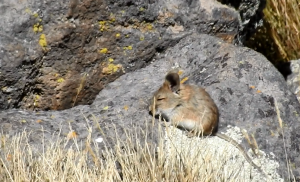ID question rodent Andes in S Peru
Hi people,
Can anyone tell me the species? I found it in the Andes of southern Peru in the Arequipa Department near Colca Canyon at an altitude somewhere around 4000 meters.

Best regards,
Pieter de Groot Boersma
4 Comments
-
amblonyx
Is it not more likely a Bolivian Big-eared Mouse? https://www.google.co.uk/search?q=bolivian+big+eared+mouse (Auliscomys boliviensis)
Here’s one we found in the Andes in Chile: http://otteradrift.com/gallery/putre/28.BolivianGreaterMouse-2.JPG
-
Vladimir Dinets
Chinchilla mouse would have much brighter coloration, with pure white underparts. I’m pretty sure it’s an Auliscomys. All three Auliscomys species are common in Colca area (or at least were common when I was there in 1995). It’s difficult to tell them apart without measurements, but A. sublimis typically has white upper surface of hindfeet, and A. pictus tends to be more golden-colored, so A. boliviensis is the most likely.
Leave a Reply
You must be logged in to post a comment.


Elias Sadalla Filho
Hi Pieter,
Do you any other photos?
It seems to be: ALTIPLANO CHINCHILA MOUSE Chinchillula sahamae